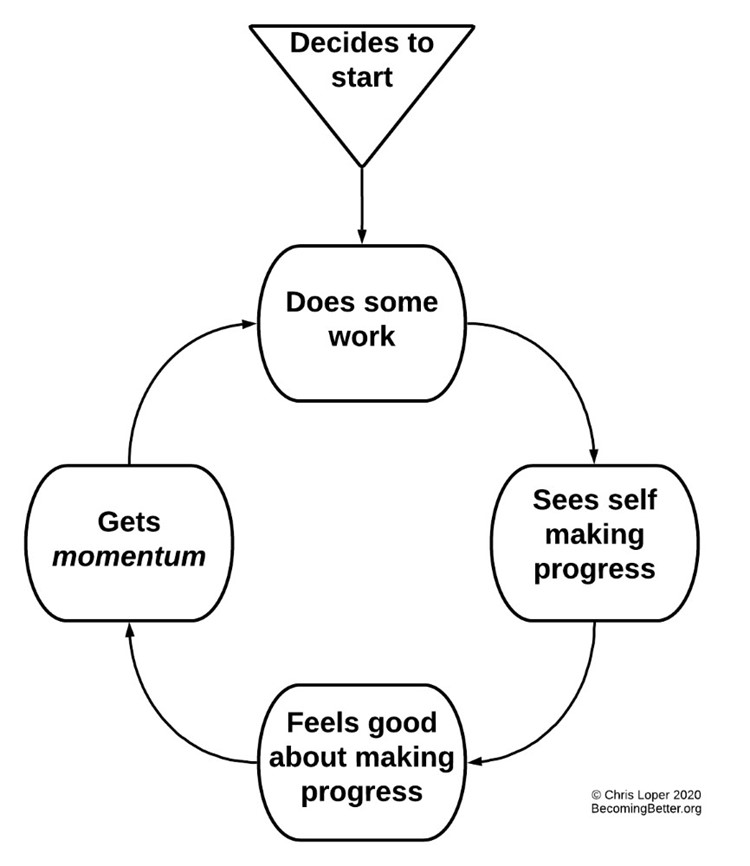
Extrinsic vs. Intrinsic Motivation: Does it Really Matter?
A lot is made of extrinsic vs. intrinsic motivation. Here’s a quick breakdown:
- Extrinsic motivation is when you’re driven by external rewards, like praise, money, and looking good.
- Intrinsic motivation is when you’re driven by internal rewards, like living up to your own values, doing what you love, and feeling better.
And there’s plenty of research showing that intrinsic motivation is more effective at driving sustained effort.1 But while intrinsic motivation is better, that’s not the most important thing to focus on.
Most of our goals are motivated by both extrinsic and intrinsic factors. That’s normal, and most people find it hard to let go of their extrinsic motivations. For example, I work out every day for intrinsic reasons: I find exercise to be satisfying, and morning workouts boost my mood and mental energy for the rest of the day. But I also like looking good; seeing my muscles in the mirror is motivating. And I’m okay with that.
So instead of focusing on extrinsic vs. intrinsic motivation, let’s look at another factor that’s much more important: progress.
Whether you’re driven by extrinsic or intrinsic goals, what matters most is that you’re moving towards those goals.
Progress and Motivation
“The most effective form of motivation is progress.” –James Clear2
There’s nothing more motivating than seeing that your efforts are working:
- You put in some work.
- The work results in a small but noticeable amount of progress.
- Seeing yourself make progress feels good.
- This motivates you to continue working.

So don’t sit around waiting for motivation to show up. Start the work, and the motivation will come.
Progress Feels Good
Seeing yourself improve or seeing yourself move toward a goal feels good. It provides your brain with evidence that what you’ve just done was worthwhile. This trains your brain to anticipate even more progress – and good feelings – if you continue your efforts. And the anticipation of reward is what releases dopamine – a neurotransmitter that provides both pleasure and motivation.3
Progress feels so good that just seeing someone else make progress is exciting. That’s why my favorite part of any story is when the main character is mastering the skills they need to succeed: the young superhero learning to use their powers; the boy in Hatchet figuring out how to survive alone in the Canadian wilderness; the training montage.

Ever notice how, after reading or watching such things, you feel motivated yourself?
Or think about it this way. In which situation would you push yourself more: using a stair climber machine at the gym or climbing a mountain?
You would be far more motivated to push yourself while climbing a mountain, even if the only reason you’re doing it is exercise, simply because you’ll be making visible progress.

Some efforts, however, don’t result in immediately visible progress, so you’ll need a way to make invisible progress visible.
Effort Tracking
Why do I meditate every morning? Eight years into the habit, the answer is that I’ve experienced the benefits, which has motivated me to keep at it. But when I first started, that wasn’t the case at all. I didn’t experience a noticeable improvement in my focus, patience, or happiness for about a year. (I was improving the whole time, but it was slow and subtle.)
This is a major problem with motivation: there’s often a lag between your effort and the results, and the gap between your hard work and the benefits it will eventually bring can be seriously demotivating.
So how did I keep going?
The answer is effort tracking. I kept a record of my daily effort on a calendar chain. And while I couldn’t feel the progress internally, I could see it externally via the Xs on the calendar.

Furthermore, I started small (three minutes per day) and slowly added to my daily meditation, recording the increases in length as well. The progress was visible on paper long before it was evident in my day-to-day experience. And this was enough to motivate me to continue.
Hooked on Progress
“When we get a signal that we are moving forward, we become more motivated to continue down that path. In this way, habit tracking can have an addictive effect on motivation. Each small win feeds your desire.” –James Clear2
This explains why role-playing games (RPGs) like World of Warcraft are so addictive. You’re constantly improving a character in the video game – gaining new powers, increasing their stats, etc. – and the progress you “experience” drives you to keep playing.
You can take the RPG approach and apply it to your own life. You are the main character in your life’s story. You are the hero who needs new skills, new tools, and new powers in order to fulfill your quests. You are the one leveling up.*

With this attitude, you’ll easily become addicted to never-ending self-improvement.
*I recommend using an effort-tracking spreadsheet to record your progress in different areas, tracking your stats like a video game would.
It’s Not About Winning
The other lesson that RPGs have to offer is that they don’t end. Sure, you might be competing against other people some of the time. You’ll run some races and fight some battles. But there’s no final victory.
The motivation you feel playing such a game isn’t about winning. It’s about the progress you make.
Likewise, the most sustainable form of motivation you can feel in life has nothing to do with achieving victory over other people. The best form of motivation comes from making progress relative to your past self.
It’s about improving, moving forward, becoming better.
It’s about being proud of how far you’ve come, even as you look forward to where you’ll go next.
1 Bontempi, Elaine. “Intrinsic and Extrinsic Motivation: Implications in School, Work, and Psychological Well-Being.” Excelsior University. May 21st, 2019.
2 Clear, James. Atomic Habits: An Easy & Proven Way to Build Good Habits & Break Bad Ones. Avery, 2018.
3 Lee, Kevan. “Your Brain on Dopamine: The Science of Motivation.” IDoneThis. October 24, 2023.
